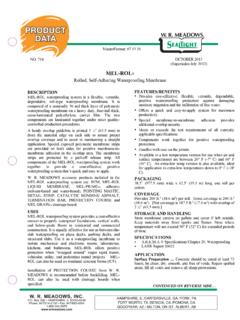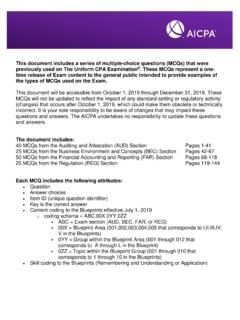Transcription of 8.1 Human waste and health - World Health Organization
1 127. 8. Sanitation Human waste and Health Faeces Human faeces may contain a range of disease-causing organisms, including viruses, bac- teria and eggs or larvae of parasites. The microorganisms contained in Human faeces may enter the body through contaminated food, water, eating and cooking utensils and by contact with contaminated objects. Diarrhoea, cholera and typhoid are spread in this way and are major causes of sickness and death in disasters and emergencies. Some y species (and cockroaches) are attracted to or breed in faeces, but while they theoreti- cally can carry faecal material on their bodies, there is no evidence that this contributes signi cantly to the spread of disease.
2 However, high y densities will increase the risk of transmission of trachoma and Shigella dysentery. Intestinal worm infections (hookworm, whipworm and others) are transmitted through contact with soil contaminated with faeces and may spread rapidly where open defecation occurs and people are barefoot. These infections will contribute to anemia and malnutrition, and therefore also render people more susceptible to other diseases. The intestinal form of schistomiasis (also known as bilharzia), caused by parasitic worm species living in the veins of the intesti- nal tract and liver, is transmitted through faeces.
3 Its complex lifecycle requires the faeces to reach water bodies where the parasite larvae hatch, pass a stage in aquatic snails and then become free-swimming infective larvae. Infection occurs through skin contact (wading, swimming) with contaminated water. Children are especially vulnerable to all the above infections, particularly when they are under the stress of disaster dislocation, high-density camp living and malnutrition. While speci c measures can be taken to prevent the spread of infection through conta- mination by Human faeces ( chlorinating the water supply, providing hand-washing facilities and soap), the rst priority is to isolate and contain faeces.
4 Urine Urine is relatively harmless, except in areas where the urinary form of schistosomiasis occurs. This parasitic infection, caused by Schistosoma haematobium, is similar to the one described in the section above, except this parasite species resides in the veins around the bladder and its eggs are excreted with urine. In these areas, urinating in water courses should be prevented; otherwise, indiscriminate urination is not a Health hazard. Sullage Wastewater from kitchens, bathrooms and laundries is called sullage. It can contain disease-causing organisms, particularly from soiled clothing, but its main Health hazard occurs when it collects in poorly drained places and causes pools of organically polluted water that may serve as breeding places for Culex mosquitoes.
5 This genus of mosquitoes transmits some viruses as well as the parasitic disease lymphatic lariasis. Mosquitoes that transmit malaria do not breed in polluted water. ENVIRONMENTAL Health IN EMERGENCIES AND DISASTERS. 128. Solid waste Rats, dogs, cats and other animals, which may be carriers (reservoirs) of disease-causing organisms are attracted to discarded food, cloth, medical dressings and other compo- nents of solid waste . Small rainwater collections in solid waste may serve as the breed- ing places for Aedes mosquitoes, vectors of the dengue virus. Deep, compacted burial and, in particular, incineration of medical waste are essential to eliminate the associated Health risks.
6 Inorganic waste , such as fuel ash, can be hazardous to Health . Items such as empty pesticide containers should be crushed and buried to ensure that they are not accidentally recycled. The importance of hygiene behaviour The links between sanitation, water supply, and Health are directly affected by hygiene behaviour. It is important to bear this in mind when considering technical options, so that facilities provided in emergencies are acceptable to the users and can be used and maintained hygienically. See Chapter 15 for more information on hygiene promotion. Strategy for excreta disposal in emergencies Excreta-disposal techniques referred to in this section are described more fully in section Situations demanding an emergency excreta-disposal response Disaster-affected urban areas Major Health risks due to inadequate excreta disposal after disasters arise in urban areas following damage to existing systems, or when parts of a city receive large numbers of displaced or homeless people, so putting increased pressure on facilities that may already be under strain.
7 A rapid assessment of damage and needs is required to decide what emergency actions to take. The immediate response may include establishing or reinforcing sewage tankering services, to bypass blocked sewers or to carry out intensive septic tank or latrine empty- ing in periurban areas. Every effort should be made to allow people to use their exist- ing toilets, through temporary repairs to broken sewers and sewage treatment works. In extreme situations, it may be necessary, as a temporary measure, to discharge sewage directly into a river or the sea, or to hold it in a safe, isolated place. If this is done, the public must be informed, and any places used for this purpose should be fenced off.
8 When sections of the population can no longer use their toilets, public facilities may need to be provided, by allowing access to schools, community centers, etc., or by setting up temporary public toilets. If available, chemical toilets may be placed on street corners and emptied by municipal workers. Simple drop-hole latrines can be placed over open inspection covers, allowing excreta to drop straight into a sewer, if the sewer is still in operation and suf ciently ushed with sewage. If not, then water tankers can be used to ush them one or more times per day. Storm drains can also be used for this purpose, but only after careful consideration of the environmental risks.
9 Where bucket latrines are normally used, the collection of night soil may be disrupted by the emergency. Continued use of buckets should be encouraged and alternative arrangements made for collection and disposal ( a common neighbourhood deep- trench latrine) until collection has returned to normal. The protection and Health of the workers involved in bucket collection should be a major concern. The use of bucket latrines should be replaced by hygienic alternatives as soon as possible. 8: SANITATION. 129. In general, defecation in rivers and streams should be discouraged unless absolutely necessary, and then only if an area downstream of other Human use can be designated for the purpose.
10 Similarly, defecation in the sea should also be discouraged, especially when the population density is high or when bays, lagoons, or estuaries are used for shing. If the sea is to be used, the tides, currents and prevailing winds should be studied so that excrement does not wash back on shore, and a speci c area set aside for defecation. A neighbourhood Health committee should be organized as soon as possible (or if it already exists, identi ed and mobilized) to liaise with the public- Health authorities in making more permanent arrangements for Human excreta removal and for supervising general waste disposal.











